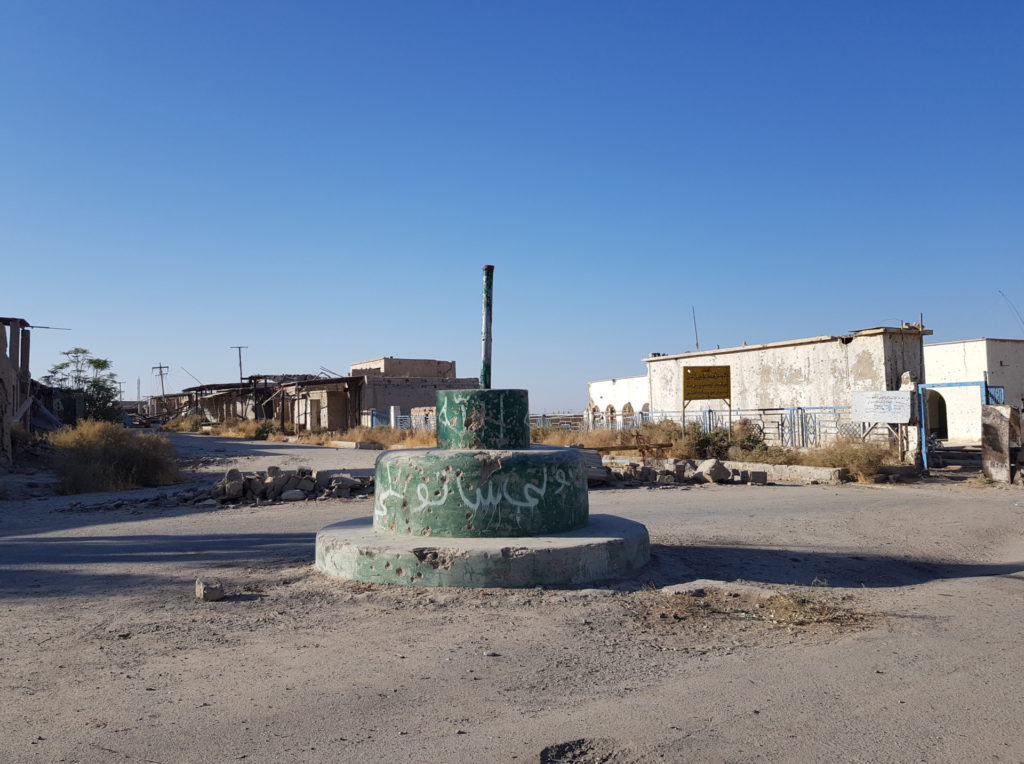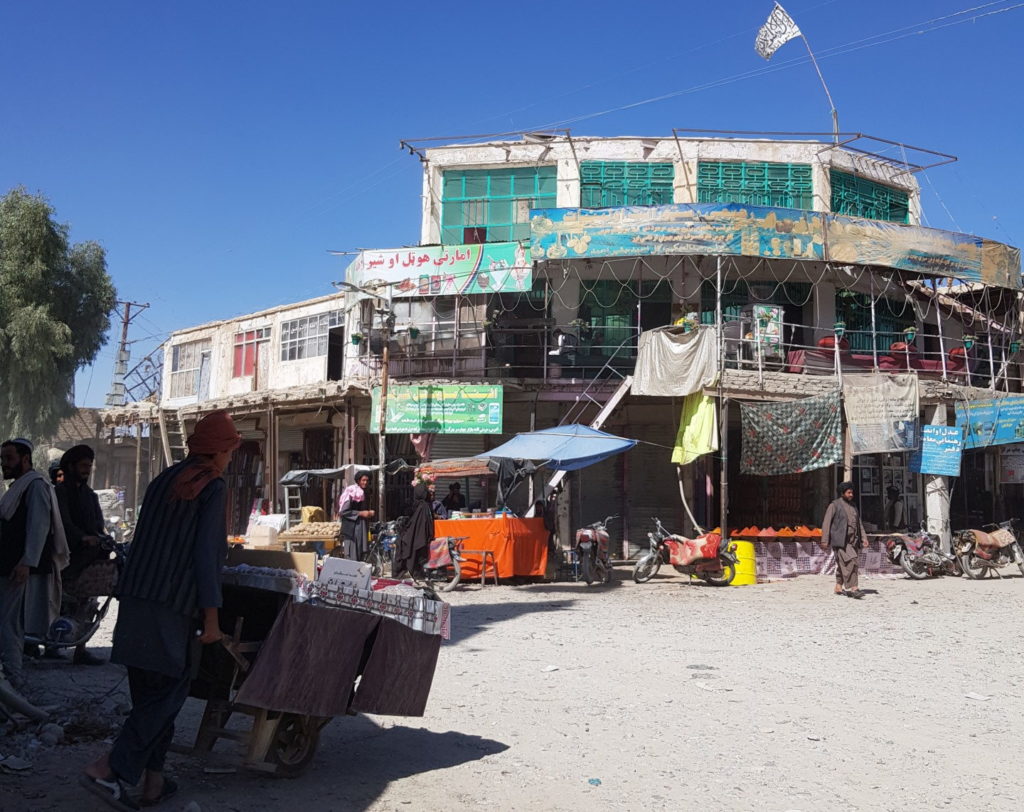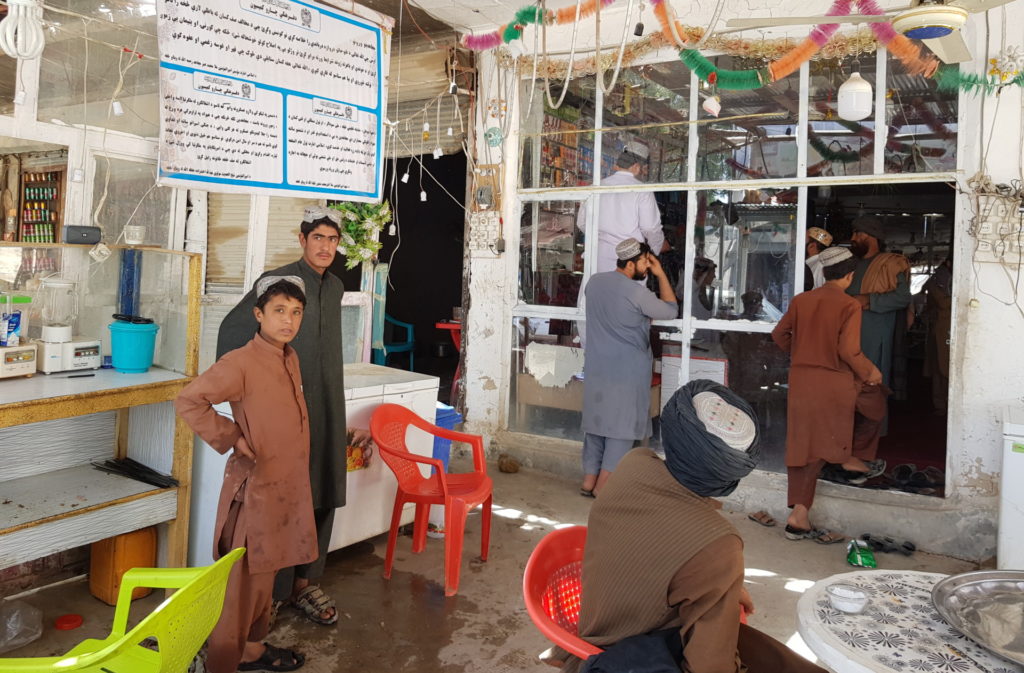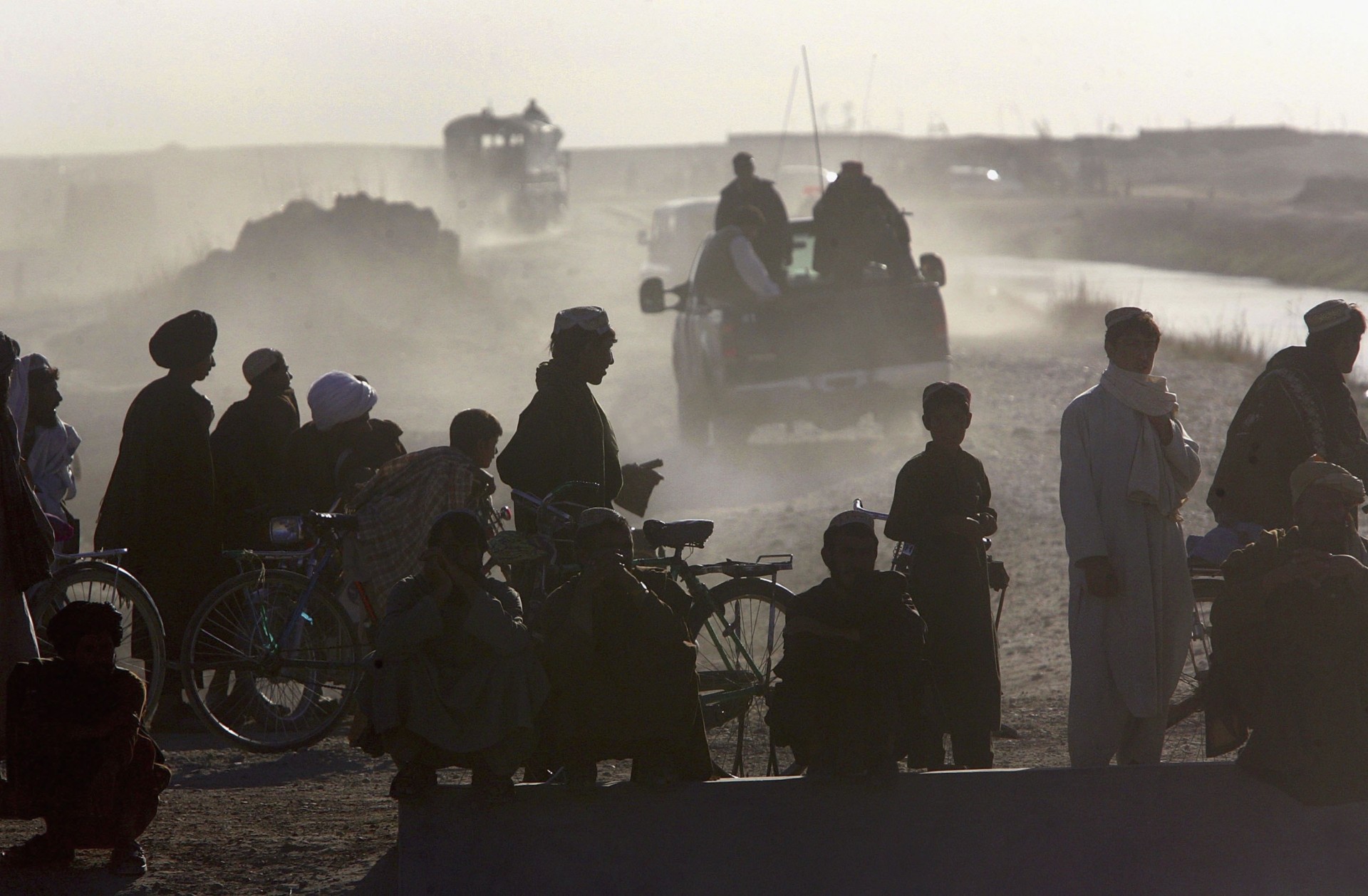Last year in Sangin, a former insurgent spoke to me fondly of a time early in the war when he sat down to eat with Abdullah Mehsud, a leader of Tehrik-e-Taliban Pakistan and a former Guantanamo detainee. Mehsud kept an assault rifle by his side and told the other diners that victory over the United States was close at hand. “Don’t give up,” the ex-insurgent remembered him saying. “We have slaughtered and skinned the cow; only its tail is left.”
Mehsud was killed in a raid by Pakistani security forces in Balochistan in 2007, but his message still resonates. While the majority of insurgents in Sangin are from in and around Helmand, foreign jihadists continue to be drawn to the district. Some come looking for shelter; others arrive determined to pass on their expertise or die as martyrs in a cause they are convinced will ultimately be venerated in Islamic history.
Sangin, in northern Helmand, the center of what is fast becoming the new Islamic Emirate of Afghanistan, reminded me of the Kabul of my youth. The old bazaar is a heap of rubble, twisted metal, and shell craters — a place of djinn and melancholia bound together only by a collective will to fight. Except it is also the deadliest place on Earth, an abattoir for a succession of American and British soldiers and now the epicenter of the very forces NATO intervened in 2001 to uproot.
The U.S. has been in Afghanistan for almost two decades — longer than any other war in its history. Three presidents have passed through the White House since the conflict began in 2001, each with markedly different strategies for beating the Taliban, or at least containing the violence. None of them succeeded.
Joe Biden will reportedly withdraw all U.S. troops from Afghanistan by September 11, the 20th anniversary of the war. Last year, the Trump administration had already signed a deal with the Taliban to withdraw all U.S. and NATO troops from Afghanistan by May this year. In exchange, the Taliban had agreed to stop fighting U.S. forces but refused to halt attacks on the Afghan government.
With just under five months to go until the deadline, Biden may see the insurgents fill the emerging power vacuum or renege on the deal and continue the occupation. Either way, the future of Afghanistan — my homeland — feels more precarious than at any point since 9/11.
To understand how it has come to this after nearly 20 years of bloodshed and sporadic hope, I decided to travel the length of Afghanistan’s most notorious frontline: a 50-mile stretch of flood plains, cornfields, villages, and towns in the southwest of the country. Home to Pashtun families who pride themselves on their piety and hospitality, this picturesque battlescape has become synonymous with the killing and maiming of hundreds of NATO soldiers and untold numbers of civilians and insurgents.


A short drive along the highway from Kandahar to Helmand lies a makeshift crossroads. On the left is a dusty intersection leading to an Afghan army base via two concrete blast walls and an armored Humvee manned by a soldier with a Soviet-era heavy machine gun. On the right is a junction worn into the sunbaked earth by tire tracks that meander toward distant mountains. It is signposted by the bullet-scarred wreckage of an abandoned CCTV tower built by Canadian troops.
Every Afghan who reaches this point must make a potentially life-or-death decision about the best route ahead. Traveling with a group of friends on a bright autumn morning last year, it was my turn.
Continuing on the highway was the quickest and most obvious option, but it meant staying in government territory, where police and local militias had set up predatory checkpoints. If we were lucky, they would ask for a small bribe and let us proceed, but we all knew innocent men who had been arrested and tortured in Kandahar’s jails. Turning left toward the army base, meanwhile, would only lead to more questions.
With no good alternatives, we swung our Toyota Corolla right at the CCTV tower. Bumping down off the asphalt, we entered a no man’s land that resembled little more than an empty space on most maps. The highway receded behind us as the car lurched and revved toward our destination: the Taliban’s emerging new state.
The tire tracks we followed from the highway had been left by insurgents and criminal gangs smuggling weapons, drugs, and people along a rat run that has existed for centuries. The route splits like the branches of a tree as it moves deeper into barren territory, with different tracks leading toward Pakistan, Iran, and eventually the Middle East. In the early years of the war, the Taliban used these tributaries to retreat and hide. Now, they are the main arteries giving life to their parallel state.
After three hours bumping through the dirt, with no government troops or insurgents in sight, we reached the outskirts of Sangin and an area called Hanjaran. There we saw our first Talibs: Two men dressed in shalwar kameez and black turbans, praying beside their motorbike. Next, we passed an old fort and a field where I was told a civilian farmer had once been killed by a drone strike.
Only when we neared the heart of Sangin did we begin to notice the Taliban’s flags: white banners emblazoned with the black script of the Shahada: “There is no God but God, and Muhammad is the messenger of God.” Some appeared to have been professionally designed — the edges straight, the writing neat, the fabric impeccably clean — others were rough and amateurish.
Sangin district center fell to the Taliban in the spring of 2017. It was a watershed moment that went largely unnoticed outside Afghanistan. Weeks later, the Trump administration used the most powerful conventional weapon in its armory to destroy a cave complex of the Islamic State group on the other side of the country. The deployment of the GBU-43/B Massive Ordnance Air Blast — the Mother of All Bombs — grabbed the world’s attention, but it may as well have been a firework for all the impact it had on the war. The real conflict, the one the U.S. was losing, was entering a pivotal new phase hundreds of miles away in this corner of Helmand.
Sangin has been a thorn in the side of U.S. and NATO forces for almost 15 years, and might yet haunt them for decades to come. British troops from the 3rd Battalion, Parachute Regiment, were sent to the district in the summer of 2006 to take over for a small detachment of U.S. troops who had been coming under attack from insurgents and drug trafficking gangs. Known as 3 Para and formed during World War II, the battalion had waged counter-insurgency operations in Yemen in the 1960s and in Northern Ireland at the height of the Troubles in the 1970s and ’80s. Nothing in the last 50 years of its history, however, would rival the horror of Sangin.
For the patchwork of tribes here, the Paras’ mission was just another chapter in an ancient story of occupation, desecration, and plunder dating back to the British Empire’s military campaigns in Afghanistan centuries earlier. Armed jihad was regarded as an obligation, not a choice, for the men of the district. Young and old, able-bodied and disabled heeded the call.
As soon as the Paras arrived, the Taliban laid siege to Sangin district center, sparking a battle for the town that lasted months. Years of intense guerrilla warfare followed. More than 100 U.K. troops had been killed in Sangin by the time the British handed control of military operations in the area to the U.S. Marines in 2010. The Americans fared better tactically but still suffered heavy casualties. At one point, according to a report in The Washington Post, Robert Gates, the U.S. defense secretary at the time, began saying nightly prayers for the Marines’ safety.
The investment of so much blood and treasure in a place that is not a major city or situated particularly close to one helped elevate Sangin to an almost mythical status for soldiers and insurgents alike. Now the mud-walled compounds of the town and the surrounding poppy and watermelon fields have taken on an even greater significance. Symbolically and strategically, Sangin could play a crucial role in shaping the Taliban’s future.
As the de facto capital of Afghanistan’s opium trade, Sangin gives the insurgents easy access to their principal source of income — drugs — and to cross-border trafficking routes. Perhaps just as crucially, it also now resonates as a beacon of Islamist resistance and a model for the Taliban’s vision of a liberated Afghanistan.
Every war has a battleground that symbolizes its fortunes, and the destruction I witnessed in Sangin brought to mind images I have seen over the years in news footage from insurgencies in Grozny, Fallujah, and Aleppo. The level of human suffering was not on the same scale, but the fighting may have a similarly galvanizing effect on new generations of insurgents.
In Sangin, just as in these other war zones, the rebels have shown a stubborn and suicidal determination to fight on. Their opponents, meanwhile, have used tactics that seem destined to push traumatized groups of Muslim men to new extremes in the months, years, and decades to come.


After the U.S. officially ended military operations in Sangin in 2014, the Taliban were able to focus all their firepower on Afghan government forces. Years of stalemate soon gave way to a period of steady progress for the insurgents. At one point, local Taliban leaders established an engineering unit to dig a network of underground bunkers and tunnels for fighters. Initially meant as a defensive measure to shelter them from house raids and air strikes, the Taliban ended up using the tunnels to stage surprise attacks on government soldiers and bases. It was typical of their innovative and brutally effective tactics.
As well as proving their skill militarily, the Taliban have tried to demonstrate that they can fulfill the mundane, bureaucratic tasks of governance. After Sangin’s old bazaar was destroyed, they built a new one right next to it, complete with privately run medical clinics, public baths, and beauty salons. The shops now sell everything from fruit juice and perfume to downloadable insurgent propaganda.
In Sangin, the Taliban remain wary of potential Afghan government offensives, and I was told that no one — including insurgents — is allowed to openly carry weapons or military equipment in the market. Anyone seeking to own a gun or a satellite phone, or even use WhatsApp, must obtain a registration document from local Taliban officials. This level of control extends to the education system in the town and surrounding villages. No schools are open, with boys of all ages and prepubescent girls allowed to attend madrassas only.
Residents seemed willing to put up with these restrictions in exchange for security. Helmand is a deeply conservative part of Afghanistan where the Taliban’s austere interpretation of Islam fits comfortably with most aspects of local culture. Entertainment comes in modest forms. On Friday afternoons, the men of Sangin like to gather on a floodplain near the wreckage of the town’s former police headquarters, where they hold wrestling matches deep into the evening. Across the district, families meet for barbecues that are famous for their locally grown sweetcorn.
Sangin’s recovery owes much to the drug trade. One opium trafficker, Haji Katozai, told me the Taliban tax his produce according to its weight. When he has paid up, they provide his buyers — whom he described as coming from outside Afghanistan — with a security detail. Like other residents, Katozai was happy just to have a certain amount of peace after years of bloodshed that he blamed on the U.S.
“I pray that no one — not only Muslims — experiences what we experienced at their hands,” he told me. “May God destroy the Americans.”
The Taliban’s district governor for Sangin is a young man named Fazeli who comes from Helmand’s provincial capital, Lashkar Gah, and was recently released from a government jail. His former office had been hit by an airstrike, so during my visit he worked alone out of a small shop in the bazaar, the sparsely furnished meeting room fitted out in traditional Afghan custom with majlis cushions on the floor.
“Don’t let his turban fall to the ground,” she told his children — a Pashtun expression that meant they must fight on in his name.
His backstory is typical of a new generation of Talibs who have come of age after 9/11. According to a close aide who spoke to me on condition of anonymity, Fazeli’s brother, Yasser, was a revered insurgent commander killed in 2016 after leading a Taliban offensive on Lashkar Gah. When news of his death reached his mother in a refugee camp in Pakistan, she hurried back to Helmand for the funeral. “Don’t let his turban fall to the ground,” she told his children — a Pashtun expression that meant they must fight on in his name.
After two days in Sangin, we made the short drive northwest to the town of Musa Qala, crossing the Helmand River on a bridge left behind by the U.S. military. At no point did we feel in danger.
Musa Qala fell to the Taliban with ease in the summer of 2015 and is now regarded as the political center of the insurgency in Helmand. Relatively unscathed by the kind of heavy combat that has decimated Sangin, it was bustling with life. Women walked the streets in headscarves, burqas, and niqabs. Music could be heard playing from car stereos, and with no local telephone networks active in the area, people were allowed to openly use satellite phones and WhatsApp. Even the smoking of cigarettes and hookah pipes was permitted in public.
One of the few social restrictions the Taliban were still actively trying to enforce concerned the creeping influence of Western fashion, but even this was done with a degree of moderation. Men who chose not to grow beards or dared to sport stylish haircuts risked being apprehended and lectured on appropriate Islamic grooming habits. Sometimes the Taliban forced them to shave their heads.
Residents told me the relaxed atmosphere in Musa Qala owed much to the February 2020 U.S.-Taliban withdrawal deal. Before then, it was common to hear the buzz of drones above the town, and anxious Taliban patrols would search passersby, looking for possible spies. That has all changed in the last year.
I saw some Talibs dressed in shalwar kameez and the hats of traffic police directing cars and buses through the town, but no armed insurgents were visible during the one day I spent in Musa Qala.
The Taliban’s presence was most noticeable in the form of statements from the movement’s national leadership pinned up outside a restaurant. One was a proclamation by the Taliban’s former head, Mullah Mohammed Omar, urging his “mujahideen brothers” to treat their Afghan opponents with respect. Another was from the Taliban’s current leader, Mawlawi Hibatullah Akhundzada, offering amnesty to government soldiers who surrendered. If they refused, they would “be killed for supporting the invaders,” it said.
Unlike in Sangin, Taliban officials in Musa Qala are able to work out of government buildings. In the governor’s compound, the militants run a 20-bed hospital and operating theater where residents can get free appendectomies and caesarean sections.
One doctor, who is in charge of a private clinic in the town, told me there is an amicable relationship between health workers and insurgents in Musa Qala. Before the Taliban’s takeover, the police had routinely harassed him and his colleagues. Now he could treat his patients in peace.
The doctor was hopeful for the long-term future of Afghanistan but worried that more bloodshed loomed around the corner. He predicted that the Taliban would make military gains while talks with the government in Kabul continued, pushing the country toward full-blown civil war.
“The Americans were strangers, so they came and then they left. But we are all Afghans, and we can’t leave. It will take some of us a long time to make peace,” he said.
After three days in the Taliban’s emerging new emirate, we began our journey home, tracing our route back through Sangin and Maiwand in our dust-covered Toyota. As we searched for the abandoned CCTV tower and the makeshift crossroads, two Talibs watched us from a distance. Fearing they might pull us over, my driver raised his hand in tentative greeting. They waved back and, with a smile, let us continue on our way.
The British author and researcher Chris Sands contributed to this story from London.



